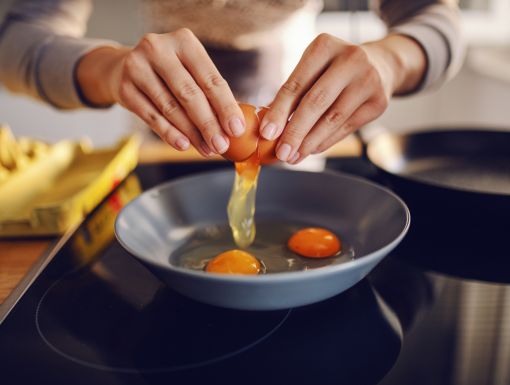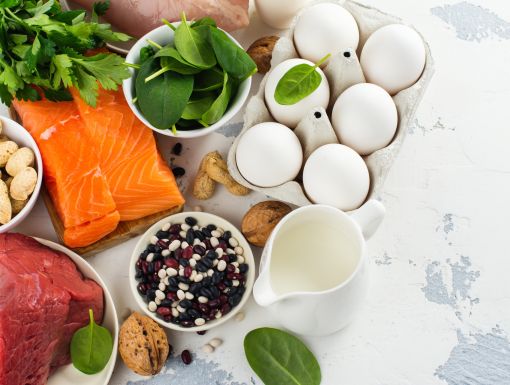
Bone Broth: Why It’s Good for You and How to Eat More of It
Bone broth isn’t just any ole broth. It’s made by simmering meat and bones (typically beef, chicken or turkey) with vegetables, herbs and spices for up to 24 hours. Its slow simmering process allows more nutrients – including collagen-rich protein – to be pulled into the savory broth. Read on to learn more about the health benefits of bone broth, what to look for on labels and how to get more of it in your diet.
Health benefits of bone broth
Bone broth is becoming readily available, with more affordable, ready-made options popping up in stores. Sip it hot by the cupful or use it as a base for your favorite soup to reap its many health benefits.
Collagen-rich broth provides our body with essential amino acid building blocks, which, along with other health benefits, help to support our body's ability to repair connective tissue like tendons, ligaments and cartilage.
Other health benefits of bone broth include:
- Good for gut health and digestion
- May improve sleep
- Can support joint health
- Boosts immune function
- May support weight loss
How to enjoy bone broth
Use bone broth in place of regular stock or broth in:
- Soups, stews, gumbo, pho
- Stuffings and dressings
- Savory sauces and gravies
- Grain-based dishes (think brown rice, wild rice and quinoa)
- Zero-proof Bloody Mary for brunch mocktails
Nutrition Facts: Bone Broth
- One cup of bone broth typically has 35-50 calories and 30-50 grams of protein.
- Sodium varies by brand from 95 milligrams to nearly 600 milligrams per cup.
- Higher-sodium, electrolyte-rich bone broth can be an excellent option for athletes who need the extra sodium, but those with high blood pressure should be mindful of the sodium content when consuming bone broth.
Top picks for store-bought bone broths and soups
Pacific Organic Bone Broth (Chicken or Turkey)
- Per cup: 35 calories, 400 milligrams sodium, 0 grams fat, 0 grams carbs, 9 grams protein
- Available in quarts and grab-and-go, single-serving cartons
- Single-serving cartons available with herbs like lemongrass, ginger, rosemary and sage
Kettle & Fire Bone Broth and Bone Broth Soup
- · Per cup: 140-190 calories, 520-630 milligrams sodium, 10-15 grams fat, 3-7 grams carbs, 8-12 grams protein
- · Flavors include Thai Curry, Miso, Tomato and Butter Curry
- · $6.50-$8.99 per 16.9-ounce container
Power Provisions Bone Broth Soup
- 210 calories, 13 grams fat, 660 milligrams sodium, 5 grams carbs, 17 grams protein
- Flavors include Coconut Thai, Creamy Tomato and Broccoli Cheddar
- $2.99 per heat-and-sip container
To schedule a nutrition consult, whether virtually or in-person, contact us at nutrition@ochsner.org or call us at 985-898-7050.
How to make bone broth
Note: Recipe sourced from The Kitchn
Ingredients:
- 2 pounds mixed beef bones, short ribs, oxtails, knuckles and neck bones
- 3 quarts water, plus more as needed to cover
- 2 tablespoons apple cider vinegar
- 1 large carrot
- 1 large yellow onion
Directions:
- Preheat oven to 400°F and rinse the bones. Arrange a rack in the middle of the oven and heat to 400°F. Place the bones in a colander, rinse under cool water and pat dry with paper towels.
- Roast the bones for 30 minutes. Arrange the bones in a single layer on a rimmed baking sheet. Roast until golden-brown, about 30 minutes.
- Cover the bones with water and the vinegar and rest for 30 minutes. Transfer the hot bones to a large stockpot. Add the water and vinegar and stir to combine. Cover and let sit for 30 minutes.
- Bring the pot to a rapid simmer over high heat.
- Skim the broth for the first hour. Immediately turn the heat down to the lowest setting possible. Check the pot occasionally, skimming off any foam that collects on the surface and adding additional water as needed to keep the ingredients covered. Cover and keep the broth at a low simmer for 24 hours.
- Add the onions and carrots and cook for another 12 to 24 hours. Add the carrots and onions and continue to simmer for 12 to 24 hours more, adding more filtered water as needed to keep the bones covered. The broth is done when it is a rich golden-brown and the bones are falling apart at the joints.
- Strain the bone broth. When the broth is finished, strain and cool it as quickly as possible. Set a strainer over a large pot or even a stand mixer bowl and line it with cheesecloth if desired. Carefully strain the bone broth into it. Discard the spent bits of bone and vegetables.
- Cool the bone broth and store. Prepare an ice bath by either filling a sink or basin with cold water and ice and set the pot of broth inside the ice bath. Stir regularly until the broth is cooled to about 50°F, about 15 minutes. Transfer the broth to airtight containers or jars. Refrigerate for up to five days or freeze up to three months.
Editor’s note: Registered dietitian Molly Kimball offers brand-name products as a consumer guide; she does not solicit product samples nor is she paid to recommend items. A version of this article originally appeared on WGNO’s “FUELED Wellness with Molly.”



